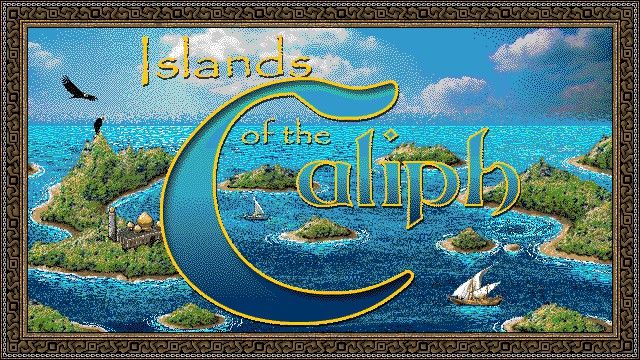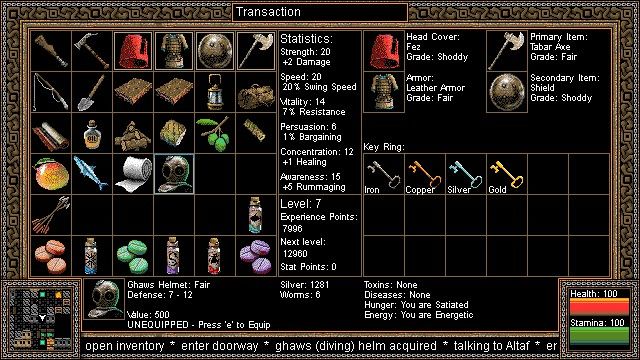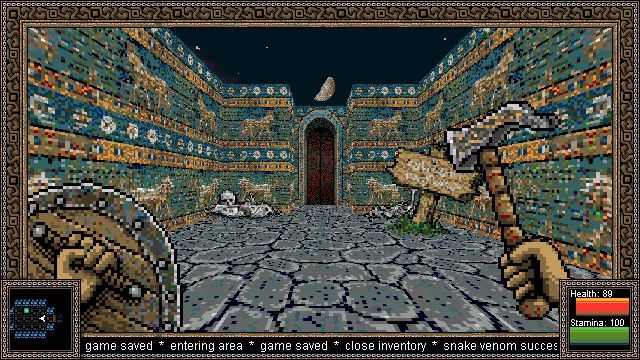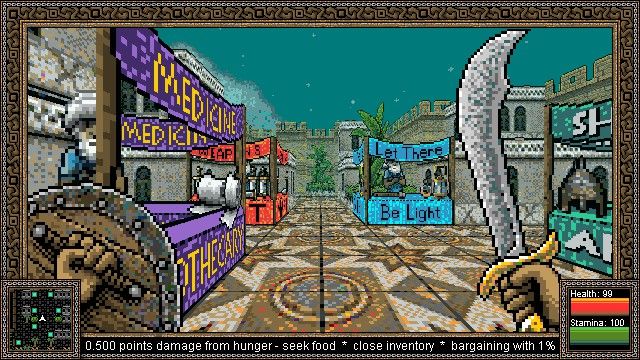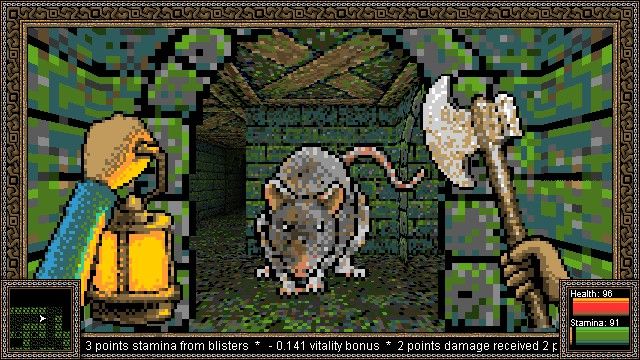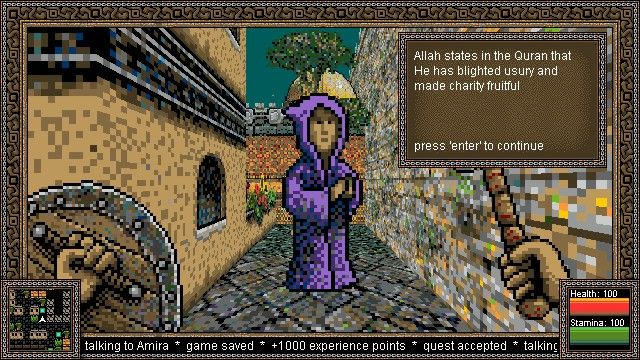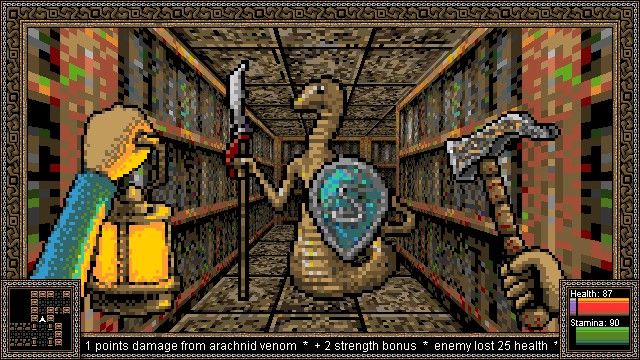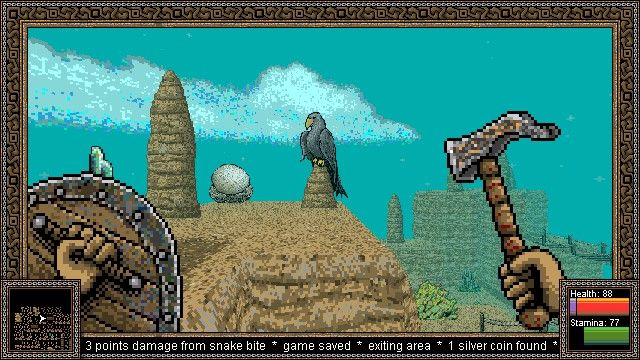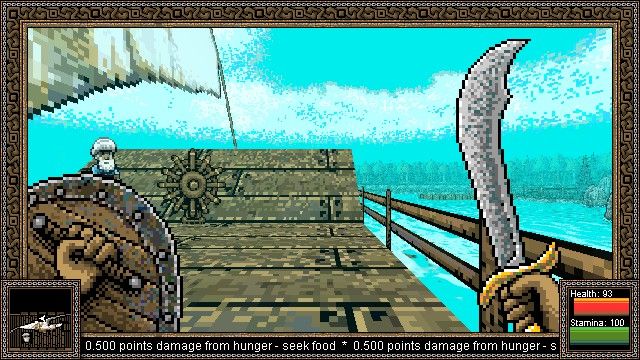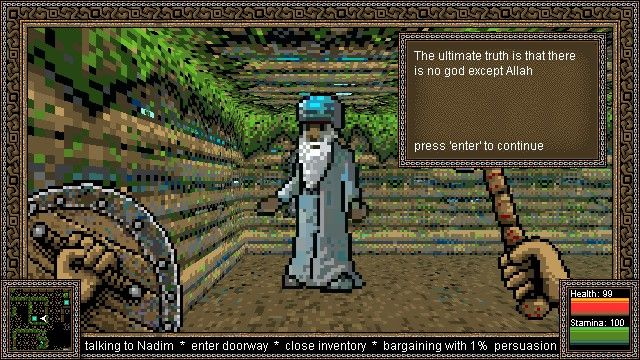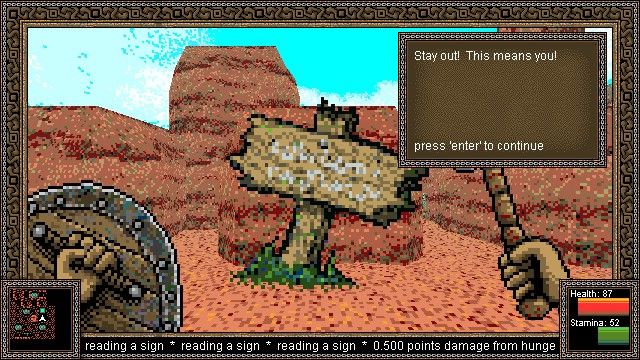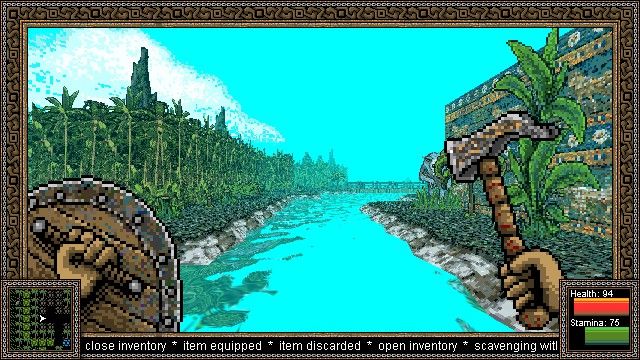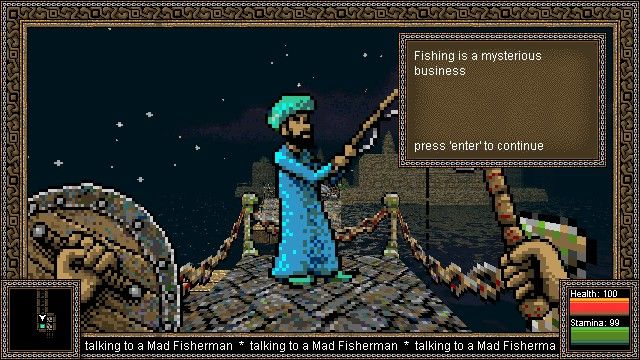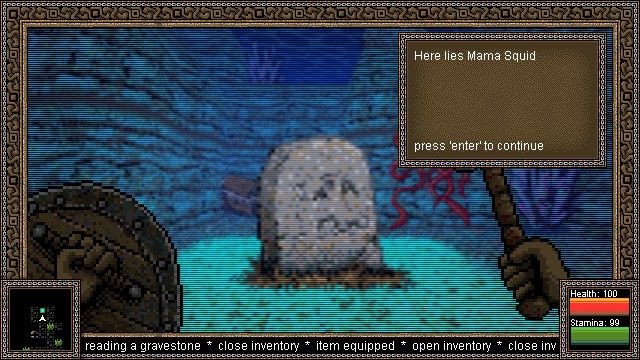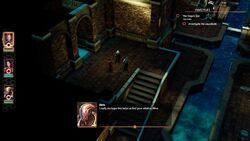RPG Codex Review: Islands of the Caliph
RPG Codex Review: Islands of the Caliph
Codex Review - posted by Infinitron on Mon 23 October 2023, 22:23:41
Tags: Islands of the Caliph; Schmidt Workshops[Review by Darth Roxor]
Bismillah ar-Rahman ar-Rahim
Every now and again, someone out there embarks on a quest to make his own RPG, all by himself in the quiet of his basement. I’ve always had tremendous respect for those who do that and manage to accomplish their goal.
Islands of the Caliph is an example of such game development. Produced by Schmidt Workshops, from what I can tell it’s for the most part a solo dev project that was announced, I believe, sometime in 2022, and it caught my attention with its first-person dungeon crawling gameplay and middle eastern flavour immediately from the get-go.
Fast forward a year and a half, and Islands of the Caliph (henceforth IotC) was released to be enjoyed by the general public. But is it actually good? You can never know with these one-man projects, because they’re just as likely to end up as shovelware, as they are to give you a gem that was made with care and a very clear vision. Let us inspect whether this one is up to par.
Watan, Sharaf, Ikhlas
The game drops you right into the middle of things without any introduction. You have to figure out (or just assume) who and where you are as you go. For simplicity’s sake, let’s say that you play the role of a hobo who one day crawls out of his tent and embarks on a tour of the local archipelago.
There is no character, much less party creation to be had. You control a single nameless protagonist who starts the game with the lowest stat scores possible and not even a dime to pay for the barest necessities. However, any customisation at the start would have been fairly pointless given how basic the character system is to begin with.
There are six statistics that range from 5 to 100. These include: Strength, Speed, Vitality, Persuasion, Concentration and Awareness. Merely looking at their effects is enough to tell you which should be raised, and which dumped without second thought.
Still, there’s at least one extra step here that I appreciate, and which makes raising stats a bit more involved than just clicking pluses. That is, they can be increased only at trainers. Their services are free, but you have to find them first and remember their locations on the islands for future reference. It’s one of the many small things that, together, serve to pull you into the game world.
I’d say the inventory has a much more important role than stats when it comes to character management, for a variety of reasons. For starters, obviously the weapons and armour you find will have a much more significant influence on damage done and resisted than your stats ever could. Armour is pretty basic – you can have a chestpiece, a helmet and a shield, the damage reduction for all armour is a range rather than a flat number, and that’s it.
Things get a little more interesting with weapons, at least on paper. There are different weapon types that serve different purposes, particularly since some of them double up as tools. A weapon has three properties: a damage range, a speed rating and a quality indicator, which influences the former two. Some, like spears or daggers, have only combat use, and their advantage is quickness. Others, like axes and hammers are slow but hard-hitting, and can be used to clear your way of trees and boulders respectively. Swords are as always the “balanced” weapon, though they can also chop down trees if they’re of exceptional quality, while bows are the only ranged weapon, and they can also be used to shoot buttons that are out of reach.
In practice, this differentiation doesn’t mean as much as it could, because you’ll still just be swinging whatever has the highest damage output, but on this front, everything mostly boils down to optimising the clutter in your backpack. For instance, you’ll want to always have a hammer with you to smash through stone, and the moment you get an exceptional sword, it’s bye-bye to whatever axe you had lying around.
Indeed, you have to approach your inventory with a lot of prioritisation in mind, because it’s much more limited than it would initially seem. You have 36 inventory slots, and every item takes up one slot, including equipped stuff, though some can be stacked. You’ll want to have full armour, a main weapon, an assortment of tools for all circumstances, a tent bag, a selection of medicines, some food, a lamp (and oil)… and the list goes on and on and on until you have only three slots left for trinkets found along the way.
Honestly, the inventory management in this game is surprisingly engaging, and at the same time surprisingly unobtrusive. Maybe it’s because every new tool gives you new opportunities and new reasons to revisit places you’ve already been to, maybe it’s that aspect of achieving the perfect preparation for what lies ahead, but it’s just very fun. Especially since the various annoyances that await you in the wilds are not completely insignificant, and for instance completely defanging the need to occasionally get back to town and rest by getting your own tent bag carries some satisfaction with it.
When it comes to the various ailments that can plague you, some are inherent, others acquired. The inherent ones include the need for food and rest. As you run around, you’ll get hungry and tired, eventually extremely so. Hunger will slowly drain your health, while exhaustion may leave you feverish and drain your stamina. Hunger is really a problem only at the very start of the game, especially on islands that are poor in food, and during Ramadan when you’re expected to fast from dawn to dusk. Exhaustion, on the other hand, can remain a bother for a longer while, especially since even with your own tent, you can only rest outdoors, so getting tired in a dungeon will effectively kick you out of it, unless you want to get ill.
Illnesses and poisons are the acquired ailments. These are mostly applied by monsters in combat, but you can also get them in other ways, like by eating raw fish or refusing to take a rest. Poisons drain your health, diseases your stamina, and each of them requires its own antidote or medication – snakebite antidote will do nothing to the spider venom coursing in your veins. Plus, the health and stamina drained by these ailments can’t be regained until you’ve had the right cure, so things can turn nasty if you don’t carry the equivalent of an apothecary’s bag with you.
The only weird thing to me when it comes to all these above ailments is that they don’t progress or impair you in any way during resting. So for instance, you can simply just sleep through hunger, or take a quick nap while poisoned and it won’t reduce your health at all. I can see some justification for this, for instance if you’re caught poisoned on an island with no healer and have to take a ship to another one, the travel time associated with this could be deadly, but I think it should still have been accounted for in some way.
Generally speaking, money quickly becomes plentiful, so buying supplies also stops being a major concern rather early – you only have to remember to keep your stocks up to avoid unpleasant surprises. Though reckless island jumping can be effective at draining your funds, since each boat trip requires buying a ticket, and for some remote islands these can be rather pricy.
Now when it comes to the actual combat, as with most things in this game, it’s simple but functional and with some ideas that are cool yet underutilised.
The combat is real-time and both you and your enemies can move around freely while exchanging blows. As you can imagine, it suffers from most of the problems typical of games like these, especially the importance of “dancing” to avoid being hit. Indeed, since your enemies’ reaction time leaves a lot to be desired and there are maybe two monster types in the entire game that have a ranged attack, against most foes you can just smack them in the face and retreat before they have a chance to retaliate.
It’s rather unfortunate that the dancing is only made more important or prominent by the typical combat situations you’ll find yourself in. Namely, you’ll mostly be fighting 1v1 against assorted varmints like giant scorpions and snakes, and because of that the combat is just very easy. A shame, too, because there are a few instances where the game shows that it could challenge you in combat more regularly. There’s a boss fight with a number of foes at the same time that can kick your ass pretty badly if you’re unprepared, while some other enemies like snakemen have very fast attack speed and appear in cramped spaces that limit your mobility. Simply forcing you to stand your ground and take a beating more often would have made the combat much more exciting.
One mechanic that suffers because of this is blocking. Blocking is an active action that stops you from attacking but significantly reduces the damage taken and also prevents all poisons and diseases applied by monsters’ attacks. The idea is nice, because you could imagine timing your blocks and strikes according to an enemy’s attack pattern, but in practice you barely ever have to use it because dancing is the much superior option. There’s even some added nuance in that you can carry either a shield or a light source in your offhand, so an increased importance of blocking would also add an interesting choice between carrying a shield or actually seeing anything in a dungeon, but as it is, nothing of the sort is really the case.
Hitting and being hit costs stamina, and when your stamina gets too low, you’ll see a dramatic decrease in both attack speed and damage, so making sure you’re fresh is somewhat important. As you get whacked, your health will go down as well, until it reaches zero. As I mentioned before, health regeneration is automatic and generous, and the same is true of stamina, though both can be replenished with items as well – bandages or food respectively.
Once you run out of health, you don’t exactly die, but instead get knocked out and washed ashore the current island. This is one of the dumber parts of this game, because upon losing all HP you can either reload the game (and autosaves happen all the time) or get KO’d for real. I don’t understand why it wouldn’t just reload, because taking the alternative not only overwrites your save (which is truly great if you missclick when you actually want to reload), it also removes a bunch of random items from your inventory. That’s right, when restarting like this you’re just as likely to lose some apples, as you are to be stripped of your gear, including unique items that can’t ever be acquired again. This is also the reason for one of the more head-scratching minor issues with IotC, which is the impossibility of dropping the starting weapon. In a game where every inventory slot is worth its weight in gold, you’re terminally stuck with a wooden club that does almost no damage, simply as a failsafe in case you ever wash up with no money and no weapon.
Aradin adh-Dhulma
So you’ve hulked up, geared up and buttered up, all that’s left is to get your ass out there into the wilds.
IotC describes itself as a “dungeon crawler”, so you can expect to explore a lot. Indeed, exploration is this game’s most prominent and best part by far, though calling it a “dungeon crawler” per se is a bit of a stretch. That’s because it doesn’t really have that many big dungeons, and you’ll be spending about as much time prowling the countryside as the underground.
Definitions aside, the exploration in this game is very fun, for a variety of reasons. The first one is definitely the vibe it exudes. The “Arabian Nights” setting is naturally mysterious but also fairly grounded – there are dudes in turbans all around, minarets in every city and ruins sticking out of the sand, while most of the supernatural elements are firmly rooted in middle eastern folklore, so you can expect to come across ghouls and manticores but not orc shamans who throw around fireballs. The only thing missing to really put the picture together is a magic carpet for fast travel.
It also has a very nicely exotic flavour, which coupled with the graphics and general style reminded me a little of Albion or the Hammerfell parts of Daggerfall. The variety in the biomes is another strong point, since each island you visit is clearly distinct, and the world map is divided into 9 of them. The environments include jungles, deserts, volcanic land and more. There’s even an underwater section, though that is basically just a short “bonus” area of sorts, which feels like a waste. The dungeons are also nicely varied, and while most of them are mysterious ruins of different sorts, each also has its own style, so one can be a dusty ancient library, another one a sorcerer’s tower, yet another a remnant of a bygone civilisation sporting weird devices, and so on.
The primary way of travelling between islands is by ship, as I mentioned before. Each island is a separate map, and each has 1-3 connections with other places, so getting from one end of the archipelago to the other can require quite a few trips. One cool detail here that I appreciate a lot is that the ships actually sail to their destinations instead of instantly teleporting. Sure, it’s nothing much, and you’ll only witness that if you’re curious enough to wait and see what happens when the ship pulls away from the quay, because you can just take some rest in the poop (aka the ship’s stern) to timeskip, but it’s still one of the many small things that come together to make the game more of a simulation.
This is where all the parts of the inventory management and preparation fit in too. The way new keys and tools found on different islands give you additional reasons to come back to places you’ve already been to strongly reinforces the open world aspect of the game while also doing wonders for the setting. That is to say, the game world actually feels like an archipelago of islands connected by various trade, cultural and diplomatic relations, instead of an assortment of levels to proceed through from 1 to 9. Plus, digging up treasures with your trusty shovel, lighting the way underground with a torch, stocking up on antivenom against those stupid overgrown snakes – all of this gives you the impression of being a real adventurer.
Another important part of the simulation experience is the game’s elaborate religion system. You could say that one of the main quests is to become a good Muslim and perform the pilgrimage to the Kaaba (aka the Hajj) – but before that you have to discover the remaining pillars of Islam, which include the creed, prayer, almsgiving and fast. And the fantastic thing is that all of these, except the first one which is just learnt once, have a direct representation in gameplay. IotC uses the full Muslim calendar, with Arabic names of days and months, and even gives some significance to the phases of the moon, which change daily. Every day is divided into prayer times, and keeping up with your prayers gives you a steady flow of XP – this even has a dedicated tool in the form of a prayer rug that you can carry around everywhere to perform your emergency prayer. Then there’s also the annual almsgiving, which entails giving away a percentage of your money, and fasting during Ramadan, which gives you XP boosts for each day of completed fast.
There are several factors that I really like and appreciate about the inclusion of religious practices in this game. For starters, they’re very respectful to both the subject matter and the player, in that they are authentic and woven well into the gameplay without feeling preachy or intrusive. In fact, I would hazard guessing that one of the major motivations behind the development of this game was to present Islam in a good light as opposed to the dumb ways it’s usually depicted in media – and the remarkable thing is that the goal was achieved successfully without having everything else suffer for it, as is often the case with works of media that are focused on religion. If anything, perhaps there was even a little too much restraint applied here, given that these practices are largely optional, and in the one situation where they truly matter, you can somewhat hand-wave them away by visiting your local mosque and getting all the “faith bonuses” without effort.
Nevertheless, the religion mechanics also have some nice conveniences to them. For instance, when you rest, you will always wake up in time for prayer, so there’s no need to keep very close tabs on that, the prayer rug makes sure you don’t have to haul ass back to town every three hours to pray, while the details on Ramadan and alms are clearly listed in your journal.
Mentioning the journal brings me to the final point I’d like to discuss in this chapter, and which also left me positively surprised. The quest design.
For the major part, the quests are very simple and basic. Usually they entail fetching something from a dungeon or delivering a message from one island to another. Nothing really ground-breaking, to be sure, but some of them, particularly the main quests, can form very long chains that can be a headache to finish. That is because they can be very expansive and involve the entire world map, but also thanks to how the game rewards paying attention to things and keeping notes – and it doesn’t hold your hand at any step of the way.
In fact, you aren’t even expected to take and finish every single quest. Some of them have borderline glowing neon signs that tell you “this is a bad idea, turn back now,” and if you do go through with them and bring a calamity upon the world with your actions, then you have only your dumb ass to blame.
Because the consequences for some of these “bad quests” can be truly catastrophic, and I have to say that you’d be hard-pressed to find a game that makes gameplay repercussions for bad choices severe enough to actually make you feel like you truly screwed up. We’re talking entire cities getting wiped, half of them being blocked, and numerous quests being temporarily inaccessible. It takes massive balls to go through with such design, and I have nothing but respect for this, especially since it’s also tremendously fun to try to fix the mess you’ve caused.
The only major point of criticism I have on this front is related to what I mentioned at the beginning of the previous chapter – there is simply no introduction or context or mention of what you’re trying to do in this world, and why you’re embarking on this whole adventure. It would have been perfectly enough to say that you’re a foreign traveller who came to the archipelago to learn about Islam. There, this is your motivation for going forward. But as it is, there’s simply no main objective to be had in this game until you progress very far into it.
Yatawajada Jinn
As far as technical matters are concerned, the game’s presentation is definitely its strong point. The graphics are very appealing and eye-catching, and they consist of a clever combo of “retro” pixel art with some modern environmental effects. I particularly like the water and fog effects, which complement the oldschool look really well and don’t at all feel out of place.
The music and sounds are alright as well. The sounds are nothing extraordinary, but they’re simply what they should be, while most have the appropriate weight and “chunkiness” for what they’re supposed to represent, particularly the various weapon and tool sounds. Meanwhile the music is clearly ethnic in the middle-eastern-folky way, and it does a good job at supporting the setting.
I’ve run into some bugs during my playthrough, but most weren’t too annoying – the only time I had to deal with an actual gamebreaking issue, I could fortunately get around it by editing the save file. Still, I’m pretty sure that most, if not all, of them have already been fixed, since the developer is very responsive and proactive on that front. I also didn’t encounter any crashes, so the game is very stable as well.
The only technical issue that strongly triggers my autism is the fact that, for some inexplicable reason, no texts in IotC ever end with a period. Put some dots at the end of these sentences, dammit.
One thing that may feel odd to you initially is the control scheme, given that IotC has no mouse support – it’s controlled fully using the keyboard. But this is not at all an issue, because the controls are fairly slick, from movement to other actions. The only thing I missed were perhaps hotkeys of some sort to quickly change between weapons and tools, as having to constantly switch them in and out inside the inventory screen was a little annoying. Obviously you can also rebind the controls to your liking, which you should, though it turns out that changing any settings is surprisingly cumbersome, at least in the game itself – instead I strongly advise to adjust them directly in the settings file, which can even be brought up from the options menu.
Absolutely Halal!
To put it briefly, Islands of the Caliph is simply a very comfy game. It’s pretty, it’s creative, and most importantly it’s just plain fun. I would say it’s “casual” in all the right ways – it’s not very demanding but by no means is it devoid of gameplay. In fact, it’s rather absorbing, which makes it a great choice for just picking it up and going off on an adventure. I doubt it’s going to win any major awards, but it’s nevertheless a very solid effort that I’m glad to have played through.
It took me 14 hours to finish the game, which is funny, because I felt like it lasted more than that. Perhaps it was due to the way I played it, with an odd hour here and there every day. Still, the length is likely why the quality remains on more or less the same level throughout the game, since everything is densely packed into this short playtime, with very little filler to be had. I’m pretty sure I also did almost everything there was to do, though a locked door in one city and a bunch of entries missing from my keyring would suggest otherwise, but I have no idea where those could be found, if they even exist to begin with.
If you’re still wary or unconvinced after reading this review, I recommend that you check the free demo. It’s very representative of the general state of the game, and a good indicator of whether you’ll have fun with the full deal or not. I know I did. Salaam, effendi.
Bismillah ar-Rahman ar-Rahim
Every now and again, someone out there embarks on a quest to make his own RPG, all by himself in the quiet of his basement. I’ve always had tremendous respect for those who do that and manage to accomplish their goal.
Islands of the Caliph is an example of such game development. Produced by Schmidt Workshops, from what I can tell it’s for the most part a solo dev project that was announced, I believe, sometime in 2022, and it caught my attention with its first-person dungeon crawling gameplay and middle eastern flavour immediately from the get-go.
Fast forward a year and a half, and Islands of the Caliph (henceforth IotC) was released to be enjoyed by the general public. But is it actually good? You can never know with these one-man projects, because they’re just as likely to end up as shovelware, as they are to give you a gem that was made with care and a very clear vision. Let us inspect whether this one is up to par.
Watan, Sharaf, Ikhlas
The game drops you right into the middle of things without any introduction. You have to figure out (or just assume) who and where you are as you go. For simplicity’s sake, let’s say that you play the role of a hobo who one day crawls out of his tent and embarks on a tour of the local archipelago.
There is no character, much less party creation to be had. You control a single nameless protagonist who starts the game with the lowest stat scores possible and not even a dime to pay for the barest necessities. However, any customisation at the start would have been fairly pointless given how basic the character system is to begin with.
There are six statistics that range from 5 to 100. These include: Strength, Speed, Vitality, Persuasion, Concentration and Awareness. Merely looking at their effects is enough to tell you which should be raised, and which dumped without second thought.
- Strength gives you a bonus of +1 damage for each 10 points. It’s by far the most expensive stat to raise, because you get only 9 stat points per level, and you won’t be levelling up a lot. By the end of the game, I reached only level 10. Furthermore, this bonus isn’t even too meaningful given that the damage inherent to weapons quickly starts exceeding 10-20.
- Speed makes you swing faster, with 1% higher attack speed for each point invested. Given that combat is real time, this is perhaps the most important stat in the game, and even an increase by 10 can make a marked difference in my experience.
- Vitality gives you damage reduction and resistance to poisons and diseases, with a 1% bonus for each 2 points. I’d consider this the second most important stat, primarily for reasons of convenience – after all, prevention is the best medicine.
- Persuasion gives you a percentage discount with merchants. I think it’s 1% per 5 points, but I can’t tell, since I never raised it. Money is plentiful enough and you don’t have to do a lot of shopping anyway.
- Concentration gives you a healing bonus when using bandages. Again, no idea what that bonus might be, since this stat is patently useless given that your health replenishes generously by itself.
- Awareness gives you a chance to find random stuff in destructible containers such as barrels. Given that the said “stuff” mostly encompasses junk, this also isn’t worth raising much.
Still, there’s at least one extra step here that I appreciate, and which makes raising stats a bit more involved than just clicking pluses. That is, they can be increased only at trainers. Their services are free, but you have to find them first and remember their locations on the islands for future reference. It’s one of the many small things that, together, serve to pull you into the game world.
I’d say the inventory has a much more important role than stats when it comes to character management, for a variety of reasons. For starters, obviously the weapons and armour you find will have a much more significant influence on damage done and resisted than your stats ever could. Armour is pretty basic – you can have a chestpiece, a helmet and a shield, the damage reduction for all armour is a range rather than a flat number, and that’s it.
Things get a little more interesting with weapons, at least on paper. There are different weapon types that serve different purposes, particularly since some of them double up as tools. A weapon has three properties: a damage range, a speed rating and a quality indicator, which influences the former two. Some, like spears or daggers, have only combat use, and their advantage is quickness. Others, like axes and hammers are slow but hard-hitting, and can be used to clear your way of trees and boulders respectively. Swords are as always the “balanced” weapon, though they can also chop down trees if they’re of exceptional quality, while bows are the only ranged weapon, and they can also be used to shoot buttons that are out of reach.
In practice, this differentiation doesn’t mean as much as it could, because you’ll still just be swinging whatever has the highest damage output, but on this front, everything mostly boils down to optimising the clutter in your backpack. For instance, you’ll want to always have a hammer with you to smash through stone, and the moment you get an exceptional sword, it’s bye-bye to whatever axe you had lying around.
Indeed, you have to approach your inventory with a lot of prioritisation in mind, because it’s much more limited than it would initially seem. You have 36 inventory slots, and every item takes up one slot, including equipped stuff, though some can be stacked. You’ll want to have full armour, a main weapon, an assortment of tools for all circumstances, a tent bag, a selection of medicines, some food, a lamp (and oil)… and the list goes on and on and on until you have only three slots left for trinkets found along the way.
Honestly, the inventory management in this game is surprisingly engaging, and at the same time surprisingly unobtrusive. Maybe it’s because every new tool gives you new opportunities and new reasons to revisit places you’ve already been to, maybe it’s that aspect of achieving the perfect preparation for what lies ahead, but it’s just very fun. Especially since the various annoyances that await you in the wilds are not completely insignificant, and for instance completely defanging the need to occasionally get back to town and rest by getting your own tent bag carries some satisfaction with it.
When it comes to the various ailments that can plague you, some are inherent, others acquired. The inherent ones include the need for food and rest. As you run around, you’ll get hungry and tired, eventually extremely so. Hunger will slowly drain your health, while exhaustion may leave you feverish and drain your stamina. Hunger is really a problem only at the very start of the game, especially on islands that are poor in food, and during Ramadan when you’re expected to fast from dawn to dusk. Exhaustion, on the other hand, can remain a bother for a longer while, especially since even with your own tent, you can only rest outdoors, so getting tired in a dungeon will effectively kick you out of it, unless you want to get ill.
Illnesses and poisons are the acquired ailments. These are mostly applied by monsters in combat, but you can also get them in other ways, like by eating raw fish or refusing to take a rest. Poisons drain your health, diseases your stamina, and each of them requires its own antidote or medication – snakebite antidote will do nothing to the spider venom coursing in your veins. Plus, the health and stamina drained by these ailments can’t be regained until you’ve had the right cure, so things can turn nasty if you don’t carry the equivalent of an apothecary’s bag with you.
The only weird thing to me when it comes to all these above ailments is that they don’t progress or impair you in any way during resting. So for instance, you can simply just sleep through hunger, or take a quick nap while poisoned and it won’t reduce your health at all. I can see some justification for this, for instance if you’re caught poisoned on an island with no healer and have to take a ship to another one, the travel time associated with this could be deadly, but I think it should still have been accounted for in some way.
Generally speaking, money quickly becomes plentiful, so buying supplies also stops being a major concern rather early – you only have to remember to keep your stocks up to avoid unpleasant surprises. Though reckless island jumping can be effective at draining your funds, since each boat trip requires buying a ticket, and for some remote islands these can be rather pricy.
Now when it comes to the actual combat, as with most things in this game, it’s simple but functional and with some ideas that are cool yet underutilised.
The combat is real-time and both you and your enemies can move around freely while exchanging blows. As you can imagine, it suffers from most of the problems typical of games like these, especially the importance of “dancing” to avoid being hit. Indeed, since your enemies’ reaction time leaves a lot to be desired and there are maybe two monster types in the entire game that have a ranged attack, against most foes you can just smack them in the face and retreat before they have a chance to retaliate.
It’s rather unfortunate that the dancing is only made more important or prominent by the typical combat situations you’ll find yourself in. Namely, you’ll mostly be fighting 1v1 against assorted varmints like giant scorpions and snakes, and because of that the combat is just very easy. A shame, too, because there are a few instances where the game shows that it could challenge you in combat more regularly. There’s a boss fight with a number of foes at the same time that can kick your ass pretty badly if you’re unprepared, while some other enemies like snakemen have very fast attack speed and appear in cramped spaces that limit your mobility. Simply forcing you to stand your ground and take a beating more often would have made the combat much more exciting.
One mechanic that suffers because of this is blocking. Blocking is an active action that stops you from attacking but significantly reduces the damage taken and also prevents all poisons and diseases applied by monsters’ attacks. The idea is nice, because you could imagine timing your blocks and strikes according to an enemy’s attack pattern, but in practice you barely ever have to use it because dancing is the much superior option. There’s even some added nuance in that you can carry either a shield or a light source in your offhand, so an increased importance of blocking would also add an interesting choice between carrying a shield or actually seeing anything in a dungeon, but as it is, nothing of the sort is really the case.
Hitting and being hit costs stamina, and when your stamina gets too low, you’ll see a dramatic decrease in both attack speed and damage, so making sure you’re fresh is somewhat important. As you get whacked, your health will go down as well, until it reaches zero. As I mentioned before, health regeneration is automatic and generous, and the same is true of stamina, though both can be replenished with items as well – bandages or food respectively.
Once you run out of health, you don’t exactly die, but instead get knocked out and washed ashore the current island. This is one of the dumber parts of this game, because upon losing all HP you can either reload the game (and autosaves happen all the time) or get KO’d for real. I don’t understand why it wouldn’t just reload, because taking the alternative not only overwrites your save (which is truly great if you missclick when you actually want to reload), it also removes a bunch of random items from your inventory. That’s right, when restarting like this you’re just as likely to lose some apples, as you are to be stripped of your gear, including unique items that can’t ever be acquired again. This is also the reason for one of the more head-scratching minor issues with IotC, which is the impossibility of dropping the starting weapon. In a game where every inventory slot is worth its weight in gold, you’re terminally stuck with a wooden club that does almost no damage, simply as a failsafe in case you ever wash up with no money and no weapon.
Aradin adh-Dhulma
So you’ve hulked up, geared up and buttered up, all that’s left is to get your ass out there into the wilds.
IotC describes itself as a “dungeon crawler”, so you can expect to explore a lot. Indeed, exploration is this game’s most prominent and best part by far, though calling it a “dungeon crawler” per se is a bit of a stretch. That’s because it doesn’t really have that many big dungeons, and you’ll be spending about as much time prowling the countryside as the underground.
Definitions aside, the exploration in this game is very fun, for a variety of reasons. The first one is definitely the vibe it exudes. The “Arabian Nights” setting is naturally mysterious but also fairly grounded – there are dudes in turbans all around, minarets in every city and ruins sticking out of the sand, while most of the supernatural elements are firmly rooted in middle eastern folklore, so you can expect to come across ghouls and manticores but not orc shamans who throw around fireballs. The only thing missing to really put the picture together is a magic carpet for fast travel.
It also has a very nicely exotic flavour, which coupled with the graphics and general style reminded me a little of Albion or the Hammerfell parts of Daggerfall. The variety in the biomes is another strong point, since each island you visit is clearly distinct, and the world map is divided into 9 of them. The environments include jungles, deserts, volcanic land and more. There’s even an underwater section, though that is basically just a short “bonus” area of sorts, which feels like a waste. The dungeons are also nicely varied, and while most of them are mysterious ruins of different sorts, each also has its own style, so one can be a dusty ancient library, another one a sorcerer’s tower, yet another a remnant of a bygone civilisation sporting weird devices, and so on.
The primary way of travelling between islands is by ship, as I mentioned before. Each island is a separate map, and each has 1-3 connections with other places, so getting from one end of the archipelago to the other can require quite a few trips. One cool detail here that I appreciate a lot is that the ships actually sail to their destinations instead of instantly teleporting. Sure, it’s nothing much, and you’ll only witness that if you’re curious enough to wait and see what happens when the ship pulls away from the quay, because you can just take some rest in the poop (aka the ship’s stern) to timeskip, but it’s still one of the many small things that come together to make the game more of a simulation.
This is where all the parts of the inventory management and preparation fit in too. The way new keys and tools found on different islands give you additional reasons to come back to places you’ve already been to strongly reinforces the open world aspect of the game while also doing wonders for the setting. That is to say, the game world actually feels like an archipelago of islands connected by various trade, cultural and diplomatic relations, instead of an assortment of levels to proceed through from 1 to 9. Plus, digging up treasures with your trusty shovel, lighting the way underground with a torch, stocking up on antivenom against those stupid overgrown snakes – all of this gives you the impression of being a real adventurer.
Another important part of the simulation experience is the game’s elaborate religion system. You could say that one of the main quests is to become a good Muslim and perform the pilgrimage to the Kaaba (aka the Hajj) – but before that you have to discover the remaining pillars of Islam, which include the creed, prayer, almsgiving and fast. And the fantastic thing is that all of these, except the first one which is just learnt once, have a direct representation in gameplay. IotC uses the full Muslim calendar, with Arabic names of days and months, and even gives some significance to the phases of the moon, which change daily. Every day is divided into prayer times, and keeping up with your prayers gives you a steady flow of XP – this even has a dedicated tool in the form of a prayer rug that you can carry around everywhere to perform your emergency prayer. Then there’s also the annual almsgiving, which entails giving away a percentage of your money, and fasting during Ramadan, which gives you XP boosts for each day of completed fast.
There are several factors that I really like and appreciate about the inclusion of religious practices in this game. For starters, they’re very respectful to both the subject matter and the player, in that they are authentic and woven well into the gameplay without feeling preachy or intrusive. In fact, I would hazard guessing that one of the major motivations behind the development of this game was to present Islam in a good light as opposed to the dumb ways it’s usually depicted in media – and the remarkable thing is that the goal was achieved successfully without having everything else suffer for it, as is often the case with works of media that are focused on religion. If anything, perhaps there was even a little too much restraint applied here, given that these practices are largely optional, and in the one situation where they truly matter, you can somewhat hand-wave them away by visiting your local mosque and getting all the “faith bonuses” without effort.
Nevertheless, the religion mechanics also have some nice conveniences to them. For instance, when you rest, you will always wake up in time for prayer, so there’s no need to keep very close tabs on that, the prayer rug makes sure you don’t have to haul ass back to town every three hours to pray, while the details on Ramadan and alms are clearly listed in your journal.
Mentioning the journal brings me to the final point I’d like to discuss in this chapter, and which also left me positively surprised. The quest design.
For the major part, the quests are very simple and basic. Usually they entail fetching something from a dungeon or delivering a message from one island to another. Nothing really ground-breaking, to be sure, but some of them, particularly the main quests, can form very long chains that can be a headache to finish. That is because they can be very expansive and involve the entire world map, but also thanks to how the game rewards paying attention to things and keeping notes – and it doesn’t hold your hand at any step of the way.
In fact, you aren’t even expected to take and finish every single quest. Some of them have borderline glowing neon signs that tell you “this is a bad idea, turn back now,” and if you do go through with them and bring a calamity upon the world with your actions, then you have only your dumb ass to blame.
Because the consequences for some of these “bad quests” can be truly catastrophic, and I have to say that you’d be hard-pressed to find a game that makes gameplay repercussions for bad choices severe enough to actually make you feel like you truly screwed up. We’re talking entire cities getting wiped, half of them being blocked, and numerous quests being temporarily inaccessible. It takes massive balls to go through with such design, and I have nothing but respect for this, especially since it’s also tremendously fun to try to fix the mess you’ve caused.
The only major point of criticism I have on this front is related to what I mentioned at the beginning of the previous chapter – there is simply no introduction or context or mention of what you’re trying to do in this world, and why you’re embarking on this whole adventure. It would have been perfectly enough to say that you’re a foreign traveller who came to the archipelago to learn about Islam. There, this is your motivation for going forward. But as it is, there’s simply no main objective to be had in this game until you progress very far into it.
Yatawajada Jinn
As far as technical matters are concerned, the game’s presentation is definitely its strong point. The graphics are very appealing and eye-catching, and they consist of a clever combo of “retro” pixel art with some modern environmental effects. I particularly like the water and fog effects, which complement the oldschool look really well and don’t at all feel out of place.
The music and sounds are alright as well. The sounds are nothing extraordinary, but they’re simply what they should be, while most have the appropriate weight and “chunkiness” for what they’re supposed to represent, particularly the various weapon and tool sounds. Meanwhile the music is clearly ethnic in the middle-eastern-folky way, and it does a good job at supporting the setting.
I’ve run into some bugs during my playthrough, but most weren’t too annoying – the only time I had to deal with an actual gamebreaking issue, I could fortunately get around it by editing the save file. Still, I’m pretty sure that most, if not all, of them have already been fixed, since the developer is very responsive and proactive on that front. I also didn’t encounter any crashes, so the game is very stable as well.
The only technical issue that strongly triggers my autism is the fact that, for some inexplicable reason, no texts in IotC ever end with a period. Put some dots at the end of these sentences, dammit.
One thing that may feel odd to you initially is the control scheme, given that IotC has no mouse support – it’s controlled fully using the keyboard. But this is not at all an issue, because the controls are fairly slick, from movement to other actions. The only thing I missed were perhaps hotkeys of some sort to quickly change between weapons and tools, as having to constantly switch them in and out inside the inventory screen was a little annoying. Obviously you can also rebind the controls to your liking, which you should, though it turns out that changing any settings is surprisingly cumbersome, at least in the game itself – instead I strongly advise to adjust them directly in the settings file, which can even be brought up from the options menu.
Absolutely Halal!
To put it briefly, Islands of the Caliph is simply a very comfy game. It’s pretty, it’s creative, and most importantly it’s just plain fun. I would say it’s “casual” in all the right ways – it’s not very demanding but by no means is it devoid of gameplay. In fact, it’s rather absorbing, which makes it a great choice for just picking it up and going off on an adventure. I doubt it’s going to win any major awards, but it’s nevertheless a very solid effort that I’m glad to have played through.
It took me 14 hours to finish the game, which is funny, because I felt like it lasted more than that. Perhaps it was due to the way I played it, with an odd hour here and there every day. Still, the length is likely why the quality remains on more or less the same level throughout the game, since everything is densely packed into this short playtime, with very little filler to be had. I’m pretty sure I also did almost everything there was to do, though a locked door in one city and a bunch of entries missing from my keyring would suggest otherwise, but I have no idea where those could be found, if they even exist to begin with.
If you’re still wary or unconvinced after reading this review, I recommend that you check the free demo. It’s very representative of the general state of the game, and a good indicator of whether you’ll have fun with the full deal or not. I know I did. Salaam, effendi.
There are 63 comments on RPG Codex Review: Islands of the Caliph




